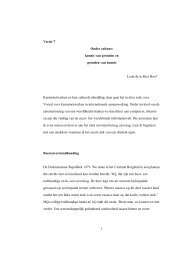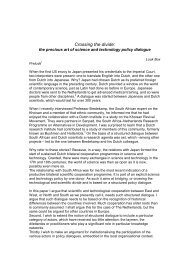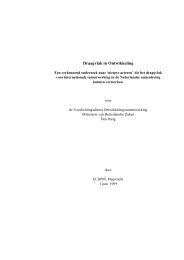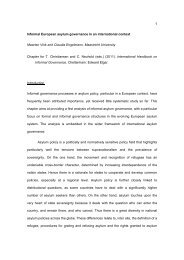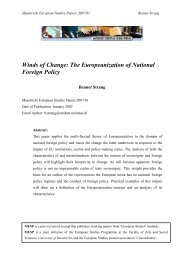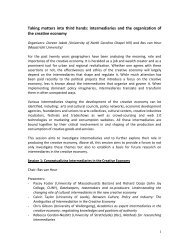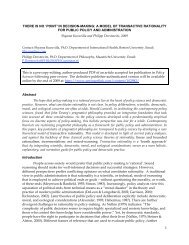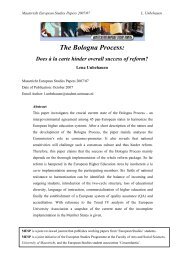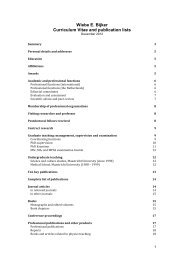the case of the synthetic dye industry, 1857–1914 - Maastricht ...
the case of the synthetic dye industry, 1857–1914 - Maastricht ...
the case of the synthetic dye industry, 1857–1914 - Maastricht ...
You also want an ePaper? Increase the reach of your titles
YUMPU automatically turns print PDFs into web optimized ePapers that Google loves.
186 J.P. Murmann and E. Homburg<br />
for winning customers because <strong>dye</strong>rs wanted to be able to mix and combine different<br />
<strong>dye</strong>s to construct <strong>the</strong>ir own fashionable shades. German companies such<br />
as Bayer could only make <strong>the</strong>se series <strong>of</strong> <strong>dye</strong>s because <strong>the</strong>y produced a large<br />
number <strong>of</strong> chemical intermediates. A firm that made many intermediates and<br />
<strong>dye</strong>s could make an even larger number <strong>of</strong> <strong>dye</strong>s because a particular <strong>dye</strong> <strong>of</strong>ten<br />
served as an intermediate for o<strong>the</strong>r <strong>dye</strong>s. Making hundreds <strong>of</strong> <strong>dye</strong>s and intermediates<br />
gave rise to <strong>the</strong> possibility <strong>of</strong> making thousands <strong>of</strong> different <strong>dye</strong>s. As<br />
a result, <strong>the</strong> number <strong>of</strong> different <strong>dye</strong>s increased exponentially with <strong>the</strong> number<br />
<strong>of</strong> different intermediates available. The leading syn<strong>the</strong>tic <strong>dye</strong> firms in Germany<br />
exploited <strong>the</strong>se scope economies and developed elaborate production schedules<br />
for producing different intermediates and <strong>dye</strong>s in <strong>the</strong> same production facilities<br />
(see van den Belt et al. 1984, for details). Because smaller firms could not afford<br />
to make <strong>the</strong> large number <strong>of</strong> intermediates required to make all possible shades<br />
<strong>of</strong> a <strong>dye</strong> family, large firms such as Bayer possessed an important competitive<br />
advantage. To be sure, a market for <strong>the</strong> high volume <strong>dye</strong> intermediates such as<br />
aniline developed over time, but such a market did not emerge for most intermediates<br />
before 1914. This had a number <strong>of</strong> reasons. First, patents protected several<br />
key intermediates. Second, for an independent firm to begin <strong>the</strong> manufacture<br />
<strong>of</strong> a particular intermediate, it had to have <strong>the</strong> perception that <strong>the</strong> size <strong>of</strong> <strong>the</strong><br />
market would be large enough to allow efficient production. Some firms such as<br />
Merk and Hahn produced intermediates on a very small scale to supply university<br />
laboratories and o<strong>the</strong>r experimental establishments. But a demand for large<br />
volumes <strong>of</strong> many <strong>dye</strong> intermediates did not exist, which would have enabled<br />
large-scale independent producers to enter <strong>the</strong> business at a pr<strong>of</strong>itable level. The<br />
large German <strong>dye</strong> firms recognized <strong>the</strong>ir advantage in producing intermediates<br />
efficiently and selectively sold some <strong>of</strong> <strong>the</strong>ir intermediates to o<strong>the</strong>r firms that<br />
were not perceived as a serious competitive threat. For all <strong>the</strong>se reasons, smaller<br />
firms were forced to concentrate on niche markets, e.g. make only blue <strong>dye</strong>s for<br />
blue and white textiles; or make black <strong>dye</strong>s for shoe polish, and so on.<br />
The syn<strong>the</strong>tic <strong>dye</strong> <strong>industry</strong> before 1914 was also characterized by a trend<br />
toward multi-plant firms. While most <strong>of</strong> <strong>the</strong> firms remained one-plant firms,<br />
some firms came to have more plants as <strong>the</strong> <strong>industry</strong> developed. In 1864 firms<br />
with two or more plants were rare. In 1913 <strong>the</strong>re were several (German) firms<br />
that operated more than four plants (in one instance even 9 plants) at home<br />
and abroad. 11 Table 2 presents <strong>the</strong> distribution <strong>of</strong> plants across firms. Our unit<br />
<strong>of</strong> analysis, which we call “firm-year,” is a particular firm in a particular year.<br />
Calculations based on firm-years produce analyses that take <strong>the</strong> life-times <strong>of</strong> <strong>the</strong><br />
firms into account. We have divided <strong>the</strong> entire period <strong>of</strong> our study (1857 to<br />
1914) into two equally long periods to examine in more detail <strong>the</strong> distribution<br />
11 In 1864, 93 firms have 99 plants; 87 are one-plant firms and 6 are two-plant firms. In 1913, 130<br />
firms have 156 plants; 114 are one-plant firms, 9 are two-plant firms, 5 are three-plant firms, 1 is a<br />
four-plant firm, and 1 is a 5-plant firm. If foreign subsidiaries are counted not as separate firms, <strong>the</strong><br />
trend toward multi-plant is even more striking. 1864: 86 firms have 99 plants, on average 1.15; 73<br />
are one-plant firms and 13 are two-plant firms. 1913: 101 firms have 166 plants, on average 1.64:<br />
77 are one-plant firms, 10 are two-plant firms, 7 are three-plant firms, 2 are four-plant firms, 2 are<br />
5-plant firms, 2 are six-plant firms, and 1 is an eight-plant firm.



